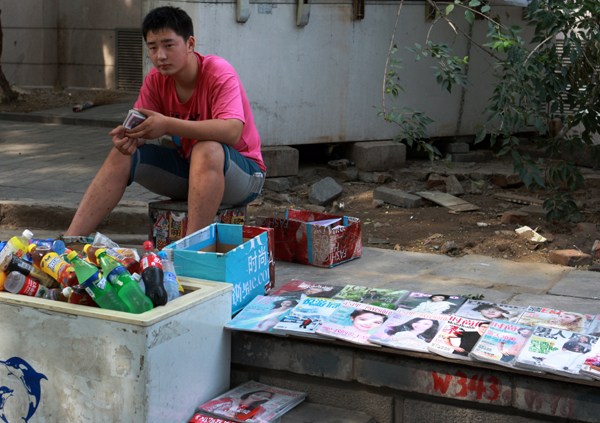 |
|
News vendor Cheng Yinghao, from Nanyang, Henan province, sells items on the street on Sunday after his newsstand was removed. Wang Zhuangfei / China Daily |
Regulations 'violated'
The 72 newsstands in the city recently removed by the authorities in Chaoyang district had violated regulations, and other districts in Beijing will begin a similar crackdown, a district official said.
"They were moved as part of a larger transformation of the district," said Han Jun, deputy director of the Chaoyang District Commission of City Administration and Environment, at a news conference on Tuesday.
Beijing currently has 2,107 newsstands in service, 1,704 of which are located in the urban areas, according to the Beijing Municipal Commission of City Administration and Environment.
Han also cited safety concerns such as fire hazards and regulatory violations, including illegal subleases, for the removal of the newsstands.
"While nine vendors affected in the latest removal said they don't want to run newsstands any more, 15 newsstands have been relocated. For newsstands that were managed illegally or done so without business licenses, we will deal with their vendors under the law," Han said.
Han Jianping, director of the landscape department at the Beijing Municipal Commission of City Administration and Environment, said other districts will follow Chaoyang to regulate newsstands.
He said Beijing municipal authorities launched a special drive on managing urban facilities and have cleared about 110 idle newsstands or newsstands that have "lost their functions" and moved about 70 newsstands that hinder pedestrian movement.
But sociologists said the impact of removing the newsstands will be felt way beyond the issues cited by the officials.
Aside from providing sources of information, newsstands also serve as "social meeting points" where residents can gather, exchange news and mingle, said Yu Hai, a sociologist at Fudan University in Shanghai.
"These residents include students, working adults and elderly people. The newsstands help provide opportunities for them to interact," he said.
"Newsstands have also become a deeply embedded and easily recognizable feature in the city.
"Any large city in the world will have newsstands. They help make the city more vibrant and stimulating, and Beijing should be no exception," Yu said.
"The sudden removal of Chaoyang's newsstands are culturally damaging to the capital and lack popular support."
Challenging situation
The removal of the newsstands is another big blow to readers and stakeholders of traditional media like Ma and Cui who were already finding it difficult to catch up with changes in the industry.
According to data from Century Chinese International Media Consultation Inc, an agency that specializes in monitoring retail data of newspapers and periodicals, newspaper circulation in China declined about 10 percent in the first half of this year, compared with the same period last year.
The decline was significant from 2012. The average annual sales volume of newsstands in China fell from about 4,570 copies of newspapers in the first half of 2012 to about 3,221 copies in the first half this year.
Metro newspapers like the Beijing Times have been the hardest hit, with retail sales down by about 17.3 percent in the first half of this year compared to that of last year, said CCMC general manager Tian Ke.
The decline in first-tier cities - Beijing, Shanghai and Guangzhou - was bigger because of their highly saturated newspaper market, Tian said.
